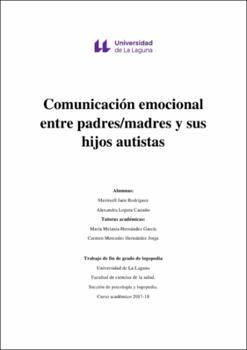Comunicación emocional entre padres/madres y sus hijos autistas
Fecha
2018Resumen
El trastorno del espectro autista (en adelante TEA) es uno de los trastornos más afectados en el área de la comunicación social, afectando en gran medida a la comunicación en lo referido a las emociones, aspecto que toca muy de cerca al ámbito familiar. Este trabajo lo que pretende es conocer cuáles son las dificultades que se presentan en la comunicación emocional entre padres y madres con sus hijos/as con autismo, además, de conocer las diferencias entre los grupos de padres y madres de niños/as con desarrollo típico y padres/madres de niños/as con autismo. Para llevar a cabo esta revisión se ha empleado un método basado en la búsqueda exclusiva de artículos a través del Punto Q y del Google Académico, teniendo en cuenta una serie de criterios de selección, centrándonos en artículos del 2013-2018 y sólo incluyendo artículos en español
e inglés, estos criterios de inclusión nos condujeron finalmente a la selección de 5
artículos. Tras la recogida de información, destacamos que existen ciertas carencias en
este tipo de comunicación por parte de los padres y madres y que existen muchos factores que a su vez la condicionan, lo que nos lleva a plantear ciertas necesidades que pueden ser tratadas a través del ámbito logopédico y la necesidad de seguir investigando más en profundidad el tema que abordamos en este trabajo. The autism spectrum disorder (hereinafter ASD) is one of the most concerned disorders in the area of social communication, greatly affecting communication in relation to emotions, an aspect that impacts very closely on the family environment. This work aims to be familiar with the difficulties that arise in the emotional communication between parents and their children with autism. In addition, its goal is to point out the differences between groups of parents of children with typical development and parents of children with autism. To carry out this review, we used a method based on the exclusive search of articles through the Q Point and Google Scholar, taking into account a series of
selection criteria, focusing on articles from 2013-2018 and only including articles in
Spanish and English. These inclusion criteria finally led us to the selection of 5 articles.
After collecting information, we emphasize that there are certain shortcomings in this
type of communication on the side of parents and that there are many factors that, at the
same condition it. This leads us to raise certain needs that can be addressed through the
speech therapy scope and the need of continuing investigating more in depth the topic that we address in this work.





